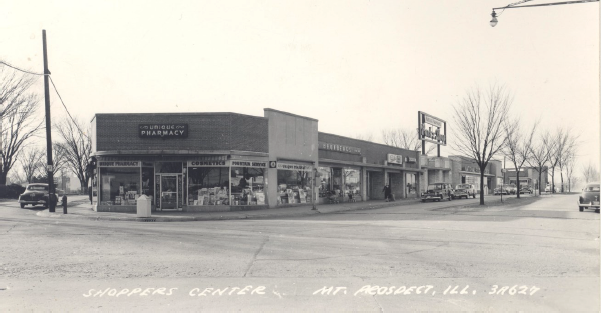by Marni Pyke – March 2021
When most people think of a historic site, a shopping center usually isn’t the image they conjure up. Imposing Victorian mansions or places like expansive battlefields seem old and unique in the 21st-century world, making them worthy of consideration as a historic site. Shopping centers, on the other hand, are a relatively modern addition to the American landscape and they seem to be everywhere. What could possibly be historic about a place like that?
Despite assumptions to the contrary, shopping centers, like Prospect Place in downtown Mount Prospect, have a historical context. Although this local shopping center is about to undergo redevelopment, the center itself is a product of earlier redevelopment.

The 1923 Drainage District Map indicates that the land on the corner of today’s Main Street and West Prospect Avenue belonged to a farmer named George Meier. It’s unclear exactly when Meier sold his land, but the Weller Creek Drainage District office ledger, which recorded land payments, shows that by late 1940 a woman named Stella C. Wilson was making payments on the property. Later in the 1940s it was the site of the annual Lions Club Fall Festival. Whenever the sale occurred, Meier was one of many local farmers during these decades who sold their farmland to investors or developers looking to build new neighborhoods.
However, the northern part of Meier’s property was destined to become the site of “one of the most modern and unusual store developments in the entire Chicago area,” according to a February 11, 1950 issue of Realty and Building magazine. This store development was originally named the Mount Prospect Park and Shop and was designed by architect Edward P. Steinberg.
The term “park and shop” was commonly used in the mid-1900s to refer to a shopping center that also provided nearby parking spaces. 21st-century Americans might instead consider a similar structure a strip mall. This type of shopping center represents an important change in retail history and in the development of the suburbs. In retail history, park and shop centers mark a change in architecture that accommodates customers and their cars. Park and shop centers were, in theory, a way to solve the congestion issues caused by increasing numbers of cars on the road.
For Mount Prospect, the park and shop served to accommodate a growing population and was a way to keep
residents shopping in downtown areas, rather than on the outskirts of town or, more significantly, in neighboring towns.
When Mayor Pendleton shoveled the first scoop of dirt during the May 1950 groundbreaking ceremony, the $250,000 Mount Prospect Park and Shop Center was planned to hold eight or IN THIS ISSUE: nine stores. The
Park and Shop opened for business in fall 1950, and the entire block of stores was completely full by the end of 1952.
Some of the earliest tenants at the Park and Shop were Reid’s Ladies Apparel, Sethness Men’s Store, Brunberg’s 5 & 10, Lenhart’s Pastry Shop, Bachmann’s Hardware Store, the National Food Store, and McMahon’s Dry Goods. While none of these early tenants remain in the shopping center, other tenants became fixtures. Keefer’s Pharmacy, Strass’ Ladies Apparel (later Mary Jayne’s Ladies Apparel), and Sam’s Place were or have been located in the Park and Shop for over 40 years.
Although the style of a park and shop center was supposed to relieve traffic congestion, the one in Mount Prospect had the opposite effect. The Mount Prospect Herald reported in December 1950, only a few months after opening, that the Village had recently imposed a two-hour parking limit on south side of West Prospect Avenue in order to
“accommodate the new stores.” Another suggestion to improve traffic involved creating a driveway space leading into the Park and Shop parking lot through the central island of grass and trees down Prospect Ave. These parking issues were part of larger downtown parking problems throughout the 1950s, so the Village eventually asked a commission to study the situation.
Over the following decades, the name “Park and Shop” disappears from the records. It seems that the Park and Shop became part of the Village landscape as the rest of the street filled in with new retail space. The building is currently called “Prospect Place Shopping Center,” but there are no records of when or why the name changed. (If you know the answer to this history mystery, please contact the Historical Society!) Though the name may be mysterious, the Prospect Place sign with the clock is instantly recognizable in the downtown landscape.
At the time of writing, the Village has approved plans to replace the shopping center with a five-story building containing first floor commercial space and apartments above. It appears that this land along West Prospect Avenue will continue the cycle of redevelopment, but this time in a new century.
